North Dakota Documents
Quitclaim Deed
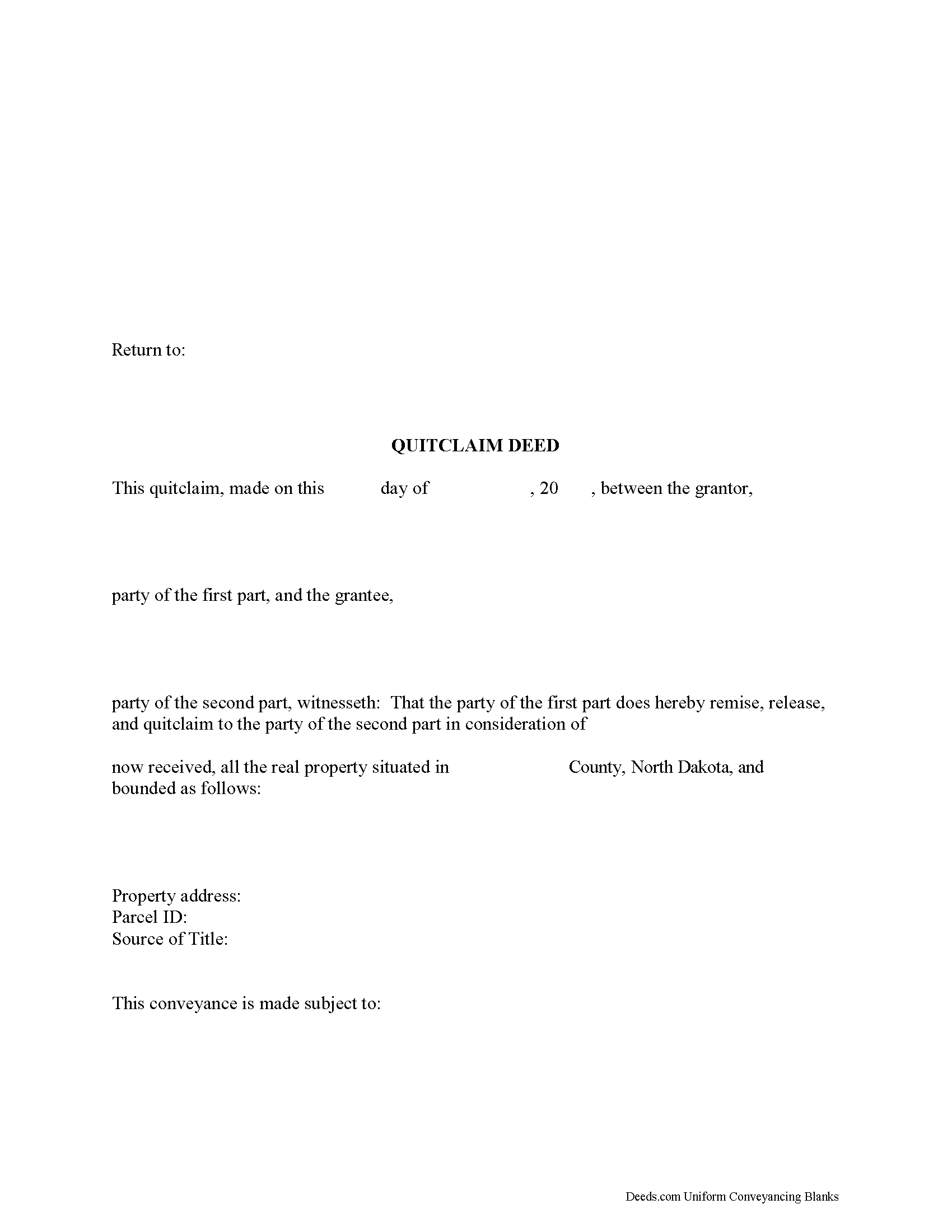
A quitclaim deed in North Dakota will take effect and will vest the interest intended to be transferred by the grantor to the grantee upon its delivery (47-09-06). The post office address of the grantee is a prerequisite to recording (47-10-07). Additional requirements, such as a Certificate of Real Estate Value, signature of the grantor, and an acknowledgment, can be found in the North Dakota information section.
Every grant of an estate in real property in North Dakota is conclusive against the grantor and everyone subsequently claiming under the grantor, except a good faith purchaser or encumbrancer who acquires a title or lien for valuable consideration by an instrument that first is duly recorded (47-10-08). Recording a North Dakota quitclaim deed provides notice of the contents to all persons (47-19-19). If a quitclaim deed is not recorded, it is void as against a subsequent good faith purchaser who purchases the same real estate for valuable consideration (or portion of it) whose conveyance, whether it is entitled to be recorded or not, is first duly recorded in the proper county in North Dakota. If a quitclaim deed is recorded first, this does not affect the question o... More Information about the North Dakota Quitclaim Deed
Gift Deed
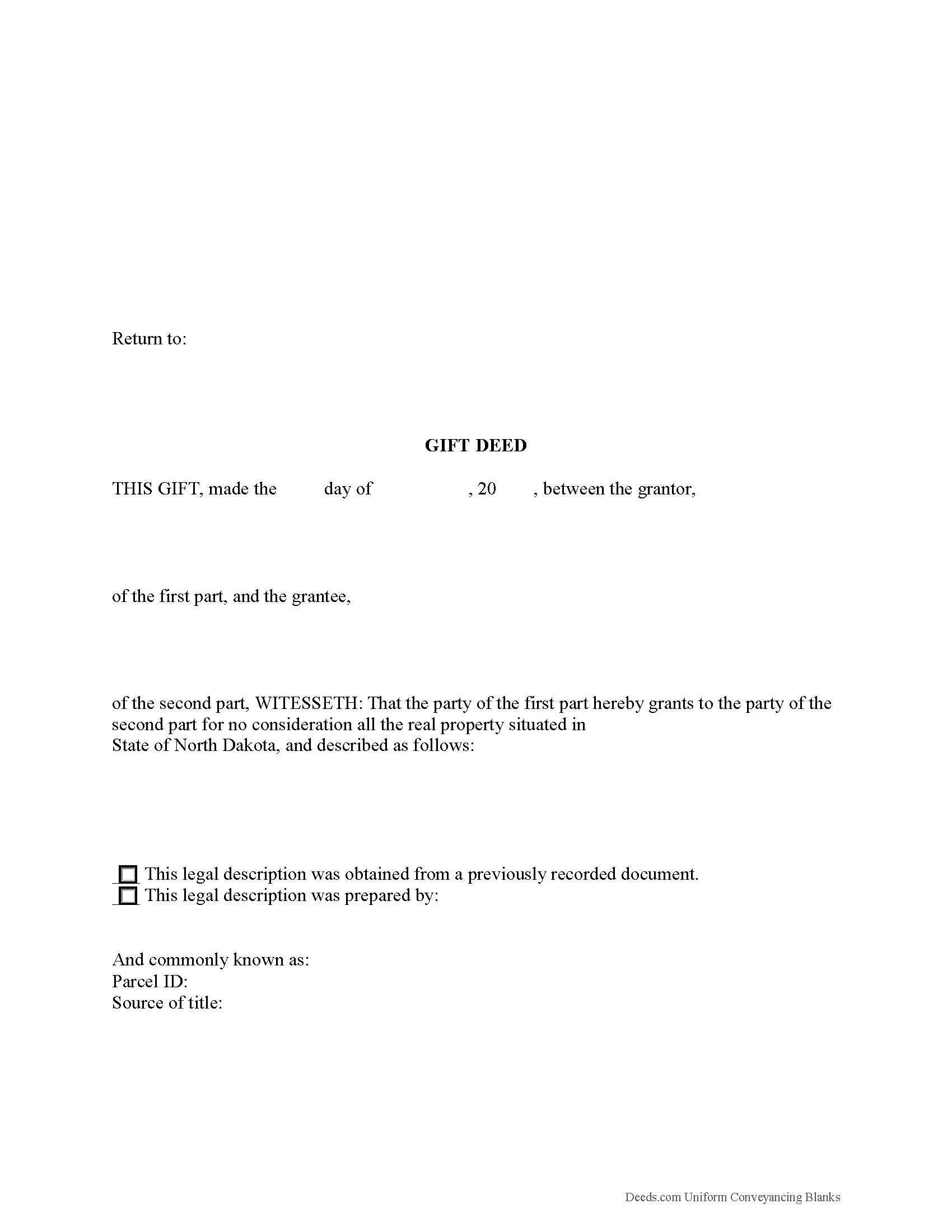
Gifts of Real Property in North Dakota
A gift deed, or deed of gift, is a legal document voluntarily transferring title to real property from one party (the grantor or donor) to another (the grantee or donee). A gift deed typically transfers real property between family or close friends. Gift deeds are also used to donate to a non-profit organization or charity. The deed serves as proof that the transfer is indeed a gift and without consideration (any conditions or form of compensation).
Valid deeds must meet the following requirements: The grantor must intend to make a present gift of the property, the grantor must deliver the property to the grantee, and the grantee must accept the gift. Gift Deeds must contain language that explicitly states no consideration is expected or required, because any ambiguity or reference to consideration can make the deed contestable in court. A promise to transfer ownership in the future is not a gift, and any deed that does not immediately transfer the interest in the property, or meet any of the aforementioned requirements, can be revoked [1].
A lawful gift deed includes the grantor's full name and marital status, as well as the grantee... More Information about the North Dakota Gift Deed
Warranty Deed
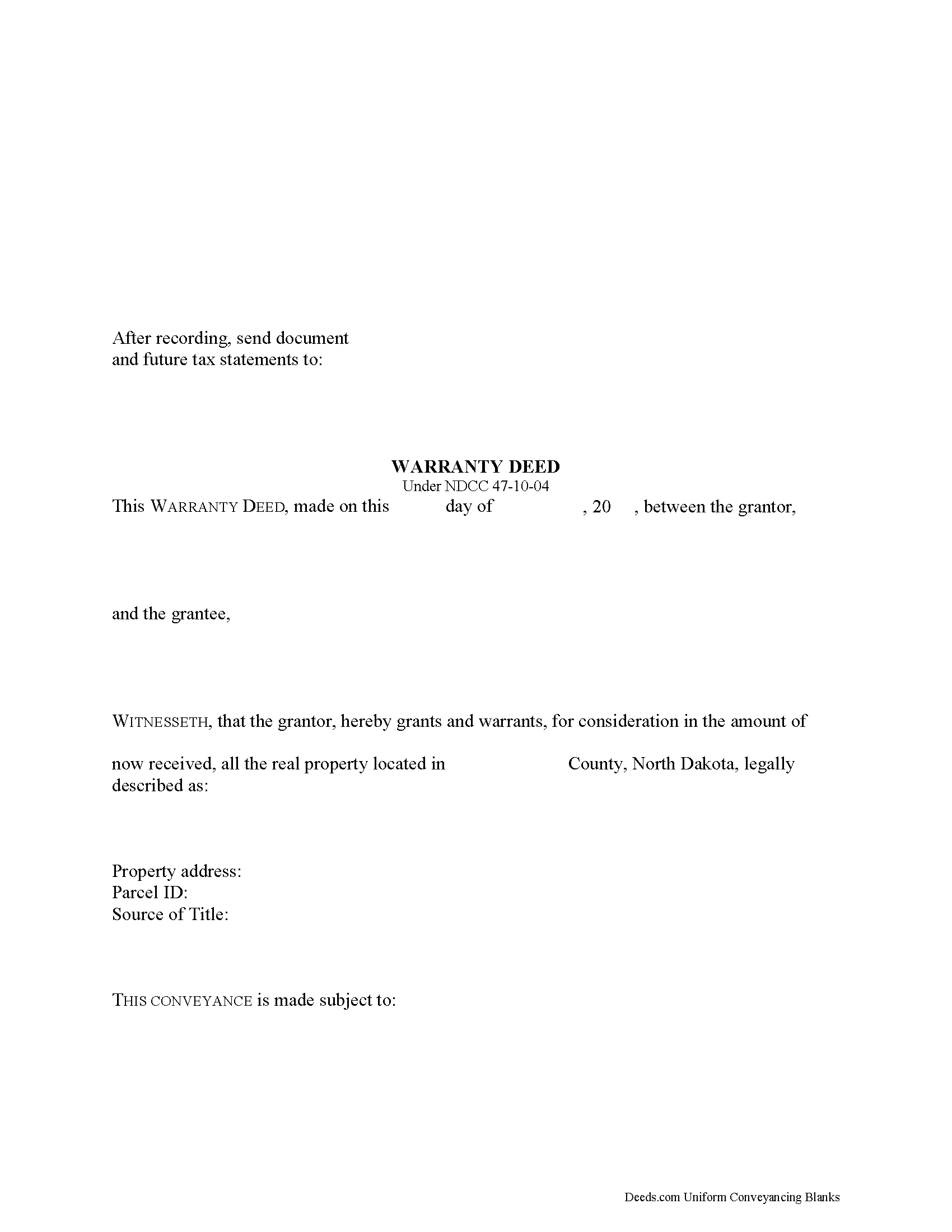
Real property in North Dakota can be transferred with a warranty deed in writing, subscribed by the grantor or the grantor's lawful agent. Real property consists of land, that which is affixed to land, that which is incidental or appurtenant to land, and that which is immovable by law (47-01-03). An agreement on the part of a seller of real property binds the seller to insert covenants of seizin, quiet enjoyment, further assurances, general warranty, and a covenant against encumbrances. These covenants are typically provided in a warranty deed. The covenants must be presented as set forth in 47-10-04 of the North Dakota Century Code. The statutory form of a grant of real property is provided in 47-10-06 of the North Dakota Century Code and can be used for a warranty deed in this state.
Before a warranty deed can be recorded in North Dakota, it must be signed and acknowledged by the grantor, and must contain original signatures (47-19-03). If a warranty deed has not been acknowledged as required, it must be proved by a subscribing witness to entitle it to be recorded (47-10-05). The proof or acknowledgment of a deed can be made at any place in North Dakota before a judge or cle... More Information about the North Dakota Warranty Deed
Special Warranty Deed
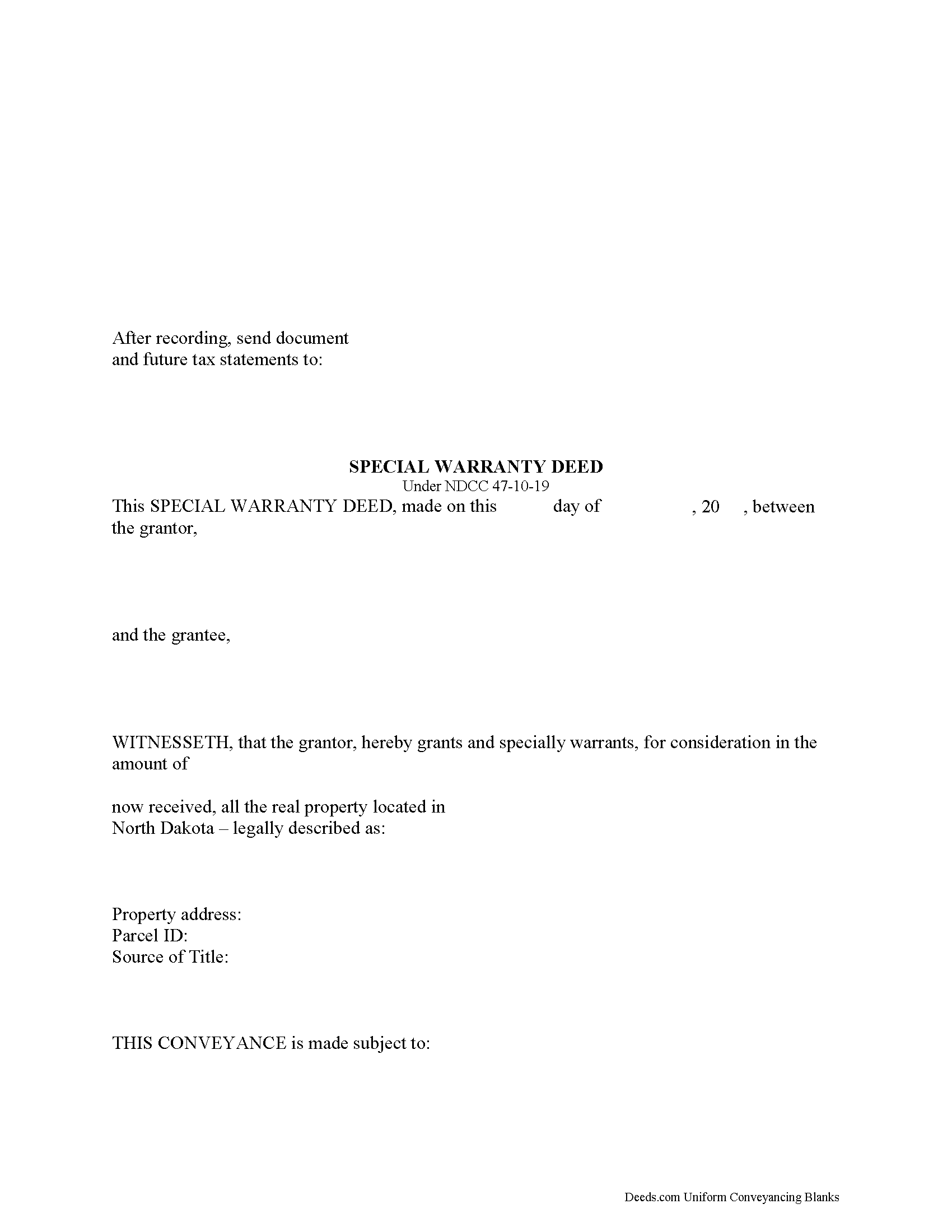
A special warranty deed can be used to transfer title to real property in North Dakota. The statutory form for a grant of real property, as presented in 47-10-06 of the North Dakota Century Code, can be used for a special warranty deed. From the use of the word "grant" in a real estate deed, the following covenants are implied, unless restrained by specific terms in the deed: (1) That previous to the execution of the conveyance, the grantor has not conveyed the same estate or any right, title, or interest therein to any person other than the grantee, and (2) That the estate is, at the time of execution of the conveyance, free from encumbrances done, made, or suffered by the grantor or any person claiming under the grantor (47-10-19.). A special warranty deed also includes a covenant from the grantor to defend the title against only the claims and demands of the grantor and those claiming by, through, or under the grantor.
In order to be recorded in North Dakota, a special warranty deed must be signed and acknowledged by the grantor, and must also contain original signatures (47-19-03). If the deed has not been acknowledged as required, it can be proved by a subscribing witness ... More Information about the North Dakota Special Warranty Deed
Grant Deed
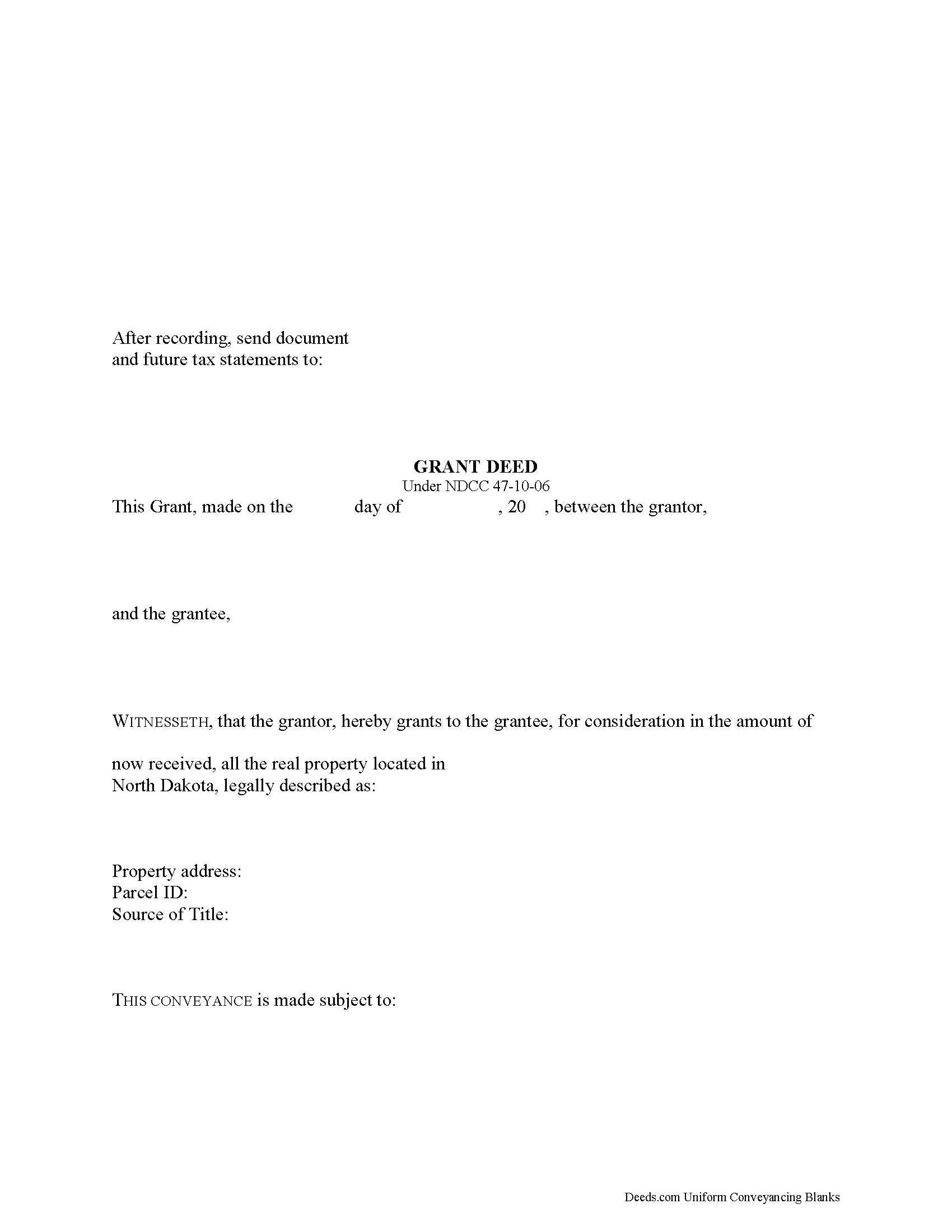
Real property in North Dakota consists of land, that which is affixed to land, that which is incidental or appurtenant to land, and that which is immovable by law (47-01-03). Title to real property can be transferred with an instrument in writing, such as a grant deed, which is sufficient to transfer title in this state. The use of the word "grant" in a real estate conveyance in North Dakota will imply the following covenants, and none other, from the grantor to the grantee: (1) Previous to the execution of the conveyance, the grantor has not conveyed the same estate, or any right, title or interest therein to any person other than the grantee, and (2) that such estate is, at the time of execution of the conveyance, free from any encumbrances done, made, or suffered by the grantor, or any person claiming under the grantor (47-10-19). The statutory form for a conveyance of real estate is in section 47-10-06 of the North Dakota Century Code.
In order to be considered for recordation by a county clerk or recorder in North Dakota, a grant deed must contain the grantor's original signature and a proper acknowledgment (47-19-03). If the deed is not acknowledged as required, it must b... More Information about the North Dakota Grant Deed
Correction Deed
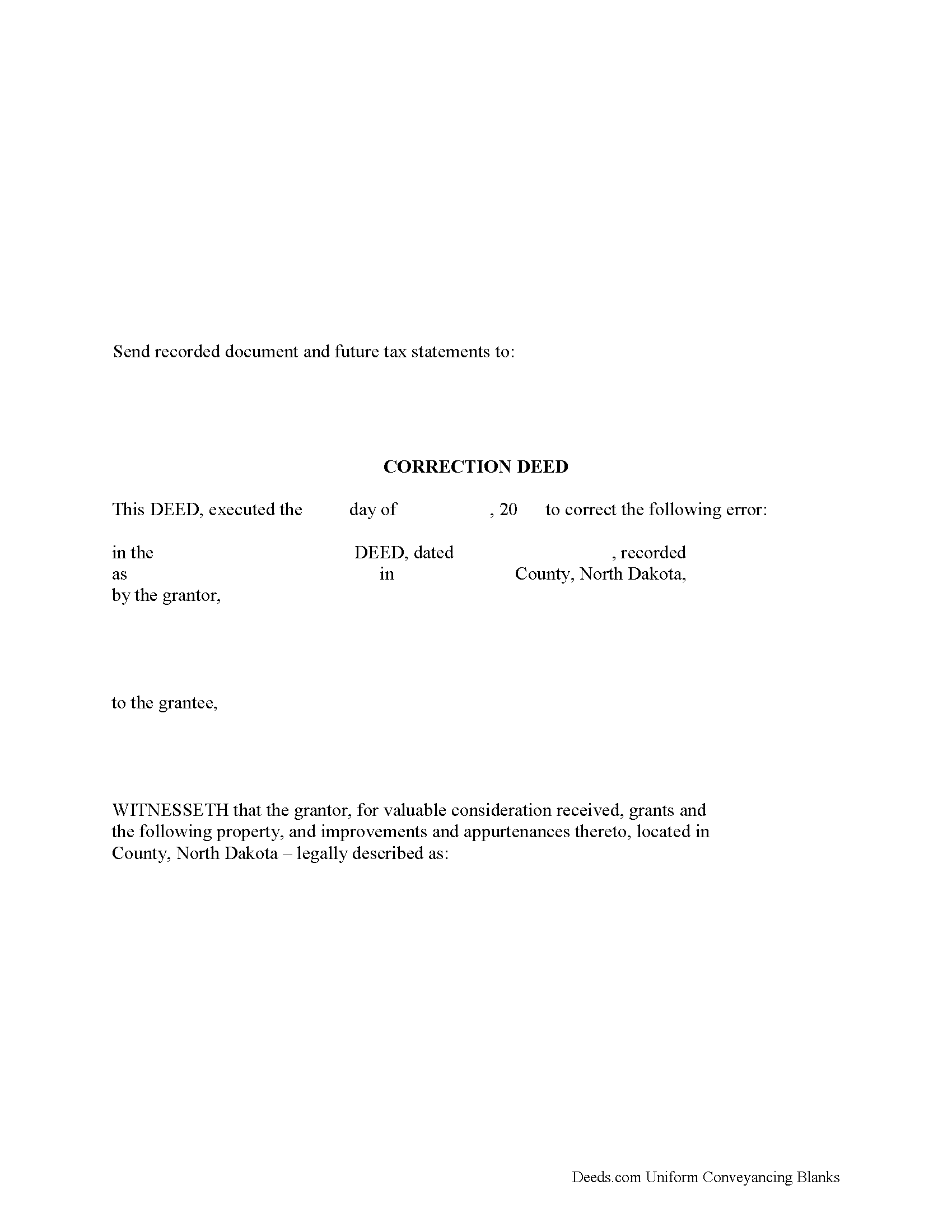
Use the correction deed to correct an error in a previously recorded deed of conveyance in North Dakota.
Correcting an error in a recorded deed helps prevent problems that might arise when the current owner tries to sell the property. The best method for correction is to prepare and record a new document, a so-called correction deed. This document does not convey title; instead, it confirms the prior conveyance of the property.
Apart from supplying the correct information, the new deed must give the reason for the correction by identifying the error. It also must reference the prior deed by title, date, and recording number. The original grantor has to sign again, which confirms the property transfer to the grantee. Generally, corrective deeds are used to address minor errors in a deed, such as typos, accidentally omitted suffixes or middle initials of names, and other minor omissions. When in doubt about the gravity of an error and whether a correction deed is the appropriate vehicle to address it, consult with a lawyer.
For certain changes, a correction deed may not be appropriate. Adding or removing a grantee, for example, or making material changes to the legal descri... More Information about the North Dakota Correction Deed
Easement Deed
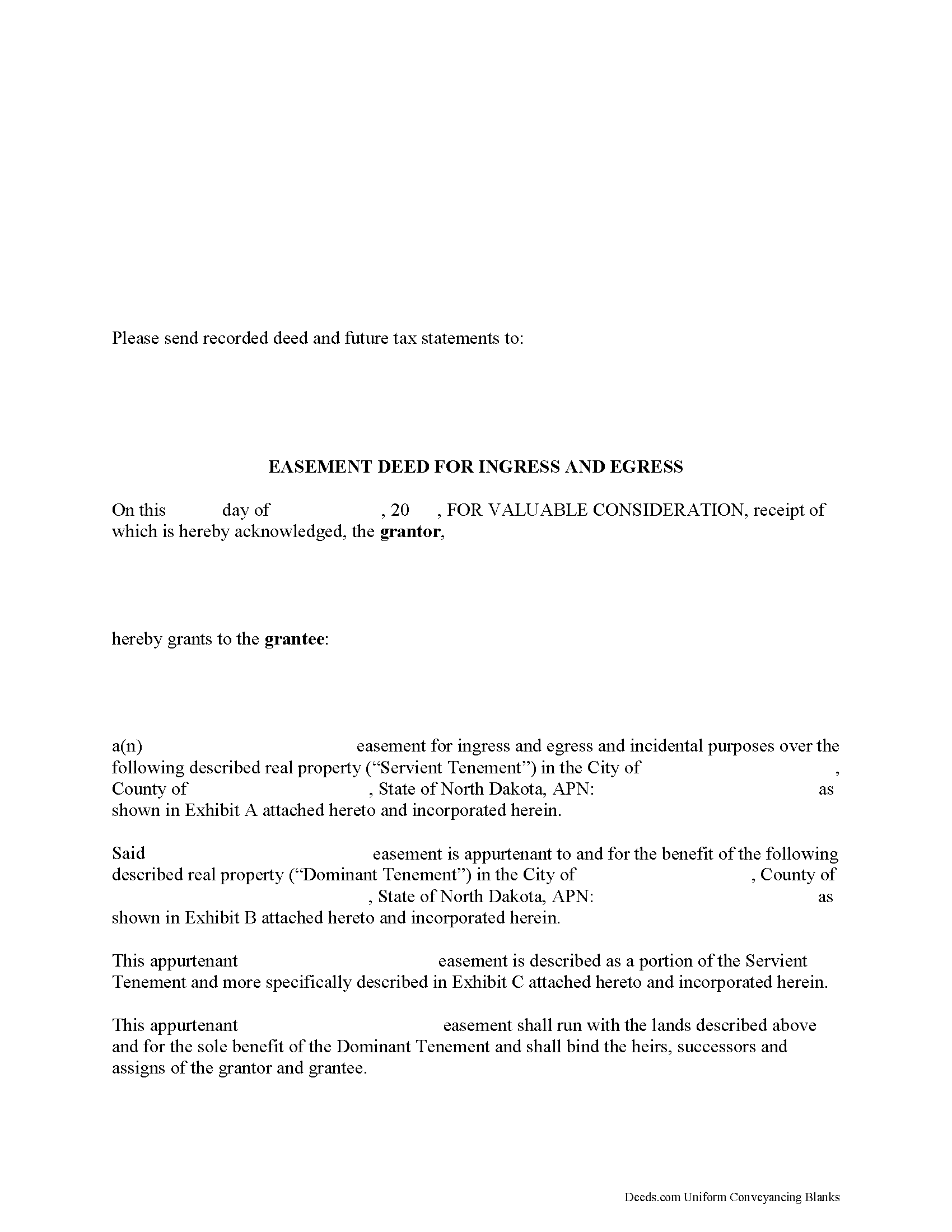
An easement allows one person to use another person's real property for a specific purpose. Section 47-05-01 of the North Dakota Century Code lists land servitudes or burdens which may be attached to other land as incidents or appurtenances, which are then called easements. Some land burdens or incidents upon land, such as the right of pasture and of fishing, the right of way, and the right of taking water, wood, or minerals, may be granted and held, though not attached to land (47-05-02). The easement deed should properly describe the area of land covered by an easement and by the interest in real property, as well as the duration of the easement (47-05-02.1). A servitude or easement can be created by one who has a vested estate in the servient tenement (47-05-05). A transfer of real estate in North Dakota will pass all the easements attached to the land (47-10-11).
As an interest in real property, an easement deed must contain the original signature of the grantor, which must also be acknowledged, in order to be presented for recording (47-19-03). If the deed has not been acknowledged, it can be proved by a subscribing witness, which will entitle it to be recorded (47-10-05). ... More Information about the North Dakota Easement Deed
Termination of Easement
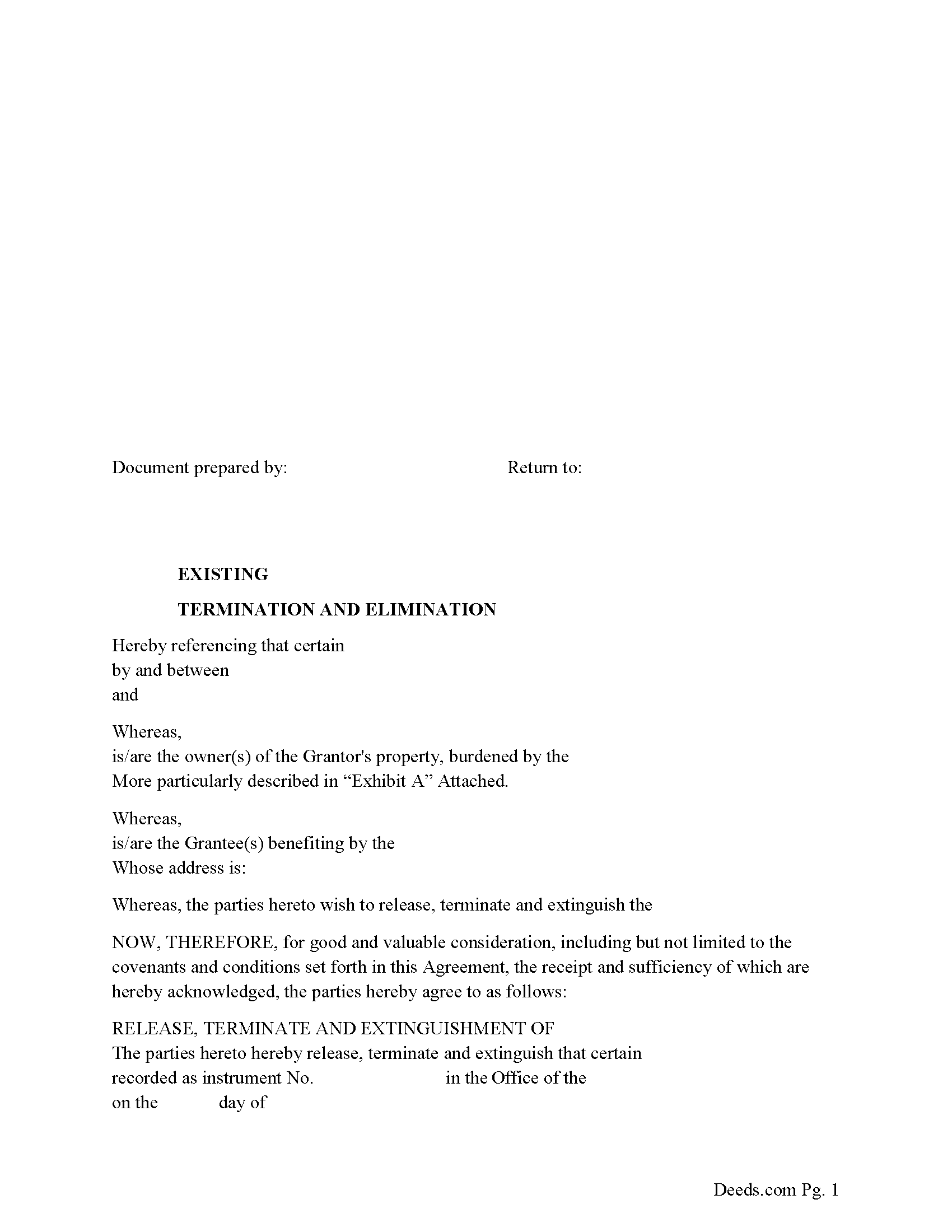
Use this form to release, terminate, extinguish a previously recorded document that involves access to and from a property.
Documents such as:
1. Easement Deeds or Agreements (An easement is a non-possessory interest in land, granting the right to use someone else's property for a specific purpose, like a driveway or utility line)
2. Access Roads
3. Right of Ways
4. Utility Easements (Power, Gas, Water, Sewer, Etc.)
5. Drainage Easements
This document allows the owner of the land, burdened by the access and the party that benefits from the access, to sign an agreement releasing the property from such access, ... More Information about the North Dakota Termination of Easement
Mineral Deed
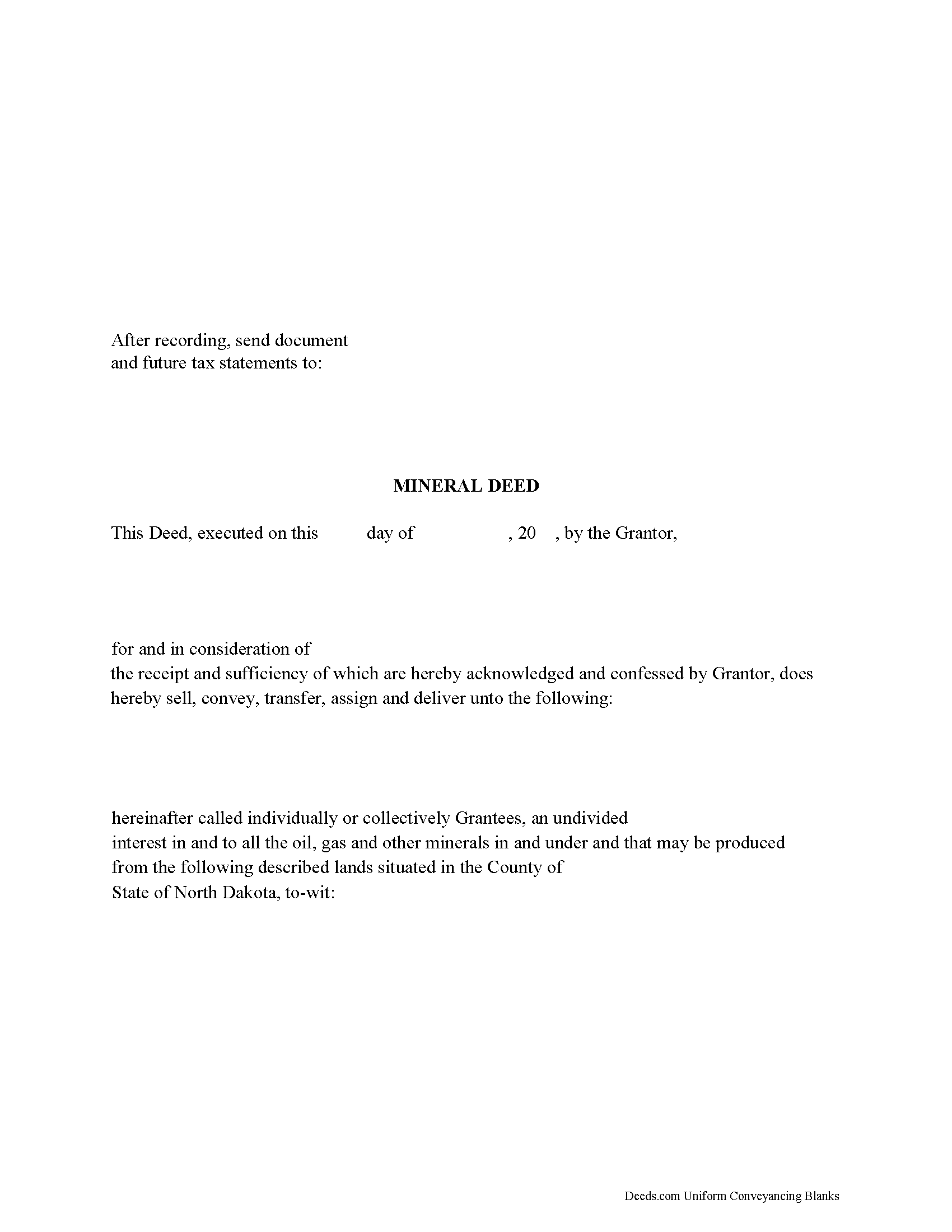
The General Mineral Deed in North Dakota transfers oil, gas, and mineral rights from the grantor to the grantee. THIS IS NOT A LEASE. There are no Exceptions or Reservations included.
The transfer includes the oil, gas and other minerals of every kind and nature. It also transfers any and all rights to receive royalties, overriding royalties, net profits interests or other payments out of or with respect to those oil, gas and other minerals. The Grantor can stipulate the percentage of Mineral Rights the Grantee will receive and is made subject to any rights existing under any valid and subsisting oil and gas lease or leases of record.
This general mineral deed gives the grantee the right to access, for the purpose of mining, drilling, exploring, operating and developing said lands for oil, gas, and other minerals, and storing handling, transporting and marketing of such.
In this document the Grantor Warrants and will defend said Title to Grantee. Use of this document has a permanent effect on your rights to the property, if you are not completely sure of what you are executing seek the advice of a legal professional.
(North Dakota MD Package includes form, guidelines, a... More Information about the North Dakota Mineral Deed
Mineral Deed with Quitclaim Covenants
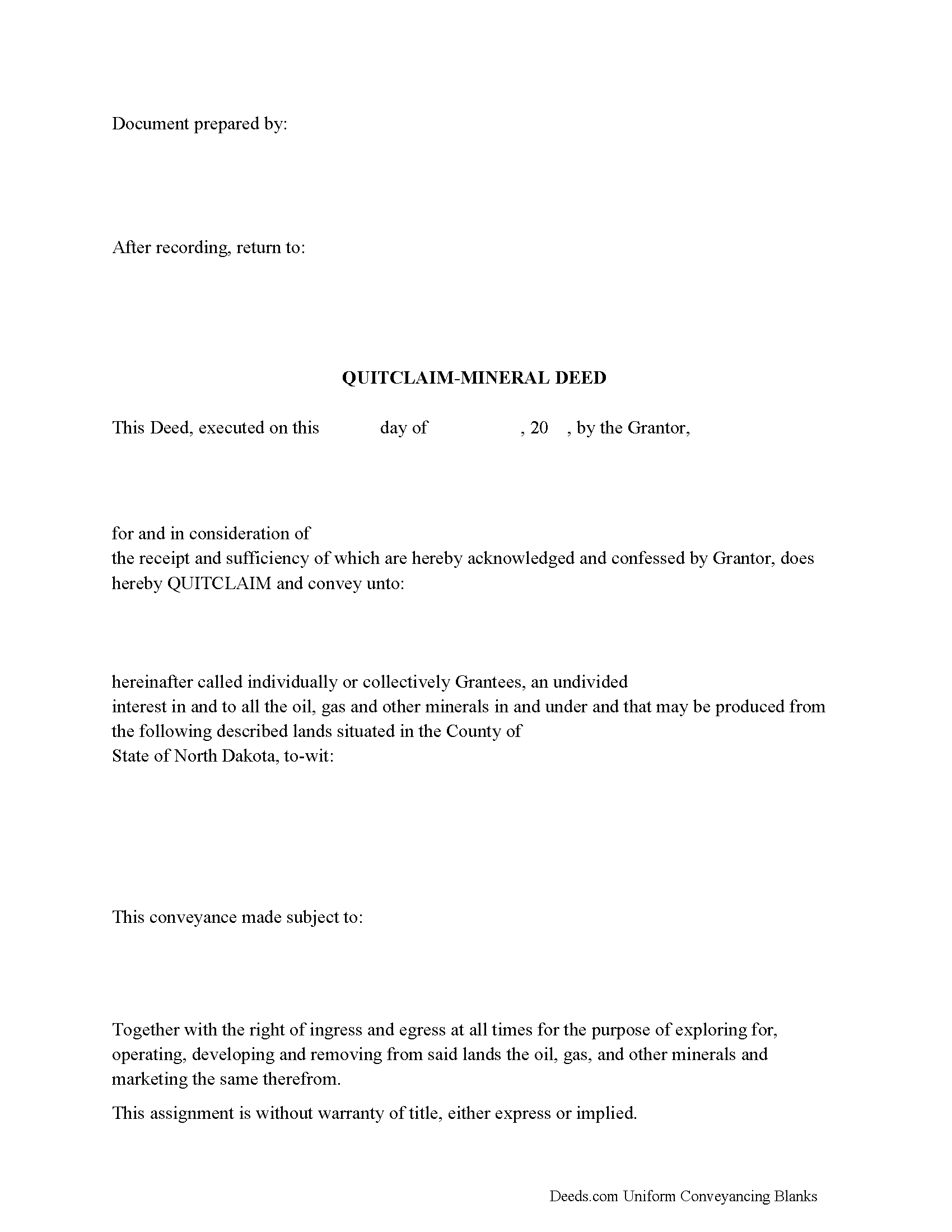
The General Mineral Deed in North Dakota Quitclaims oil, gas, and mineral rights from the grantor to the grantee. THIS IS NOT A LEASE. There are no Exceptions or Reservations included.
The transfer includes the oil, gas and other minerals of every kind and nature. The Grantor can stipulate the percentage of Mineral Rights the Grantee will receive.
This general mineral deed gives the grantee the right to access, for the purpose of mining, drilling, exploring, operating and developing said lands for oil, gas, and other minerals, and storing handling, transporting and marketing of such.
The seller, or grantor Quitclaims the mineral rights and does NOT accept responsibility to any discrepancy of title (This assignment is without warranty of title, either express or implied)
Uses: Mineral deeds with quitclaim are often used in situations where the grantor wants to quickly release any interest they might have in mineral rights, such as in settling estates, resolving disputes, clearing up uncertainties about ownership in a title's history or when mineral rights have previously been severed or fragmented from surface rights and cloud a title, making it difficult to transfer pro... More Information about the North Dakota Mineral Deed with Quitclaim Covenants
Notice of Lis Pendens
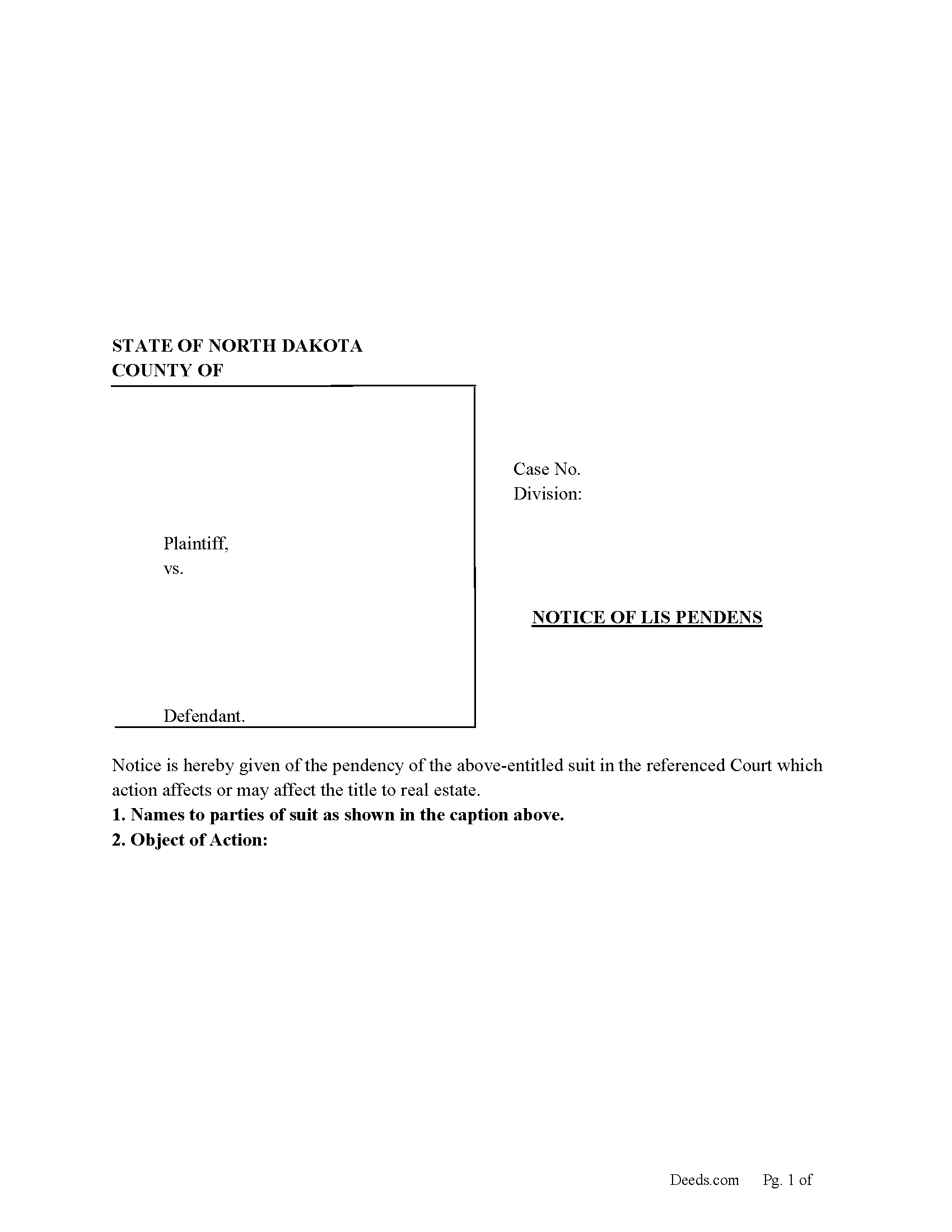
Lis Pendens Latin for SUIT PENDING
Use this form to notify the world that a case (civil or criminal) is pending affecting real property. (From the time of filing only shall the pendency of the action be constructive notice to a purchaser or encumbrancer of the property affected thereby, and every person whose conveyance or encumbrance is subsequently executed or subsequently recorded is deemed a subsequent purchaser or encumbrancer with notice and is bound by all proceedings taken after the filing of such notice to the same extent as if that person were a party to the action.) (ND 28-05-07. Lis pendens - Effect.)
A Notice of Lis Pendens is filed in an ACTION FOR PARTITION OF REAL PROPERTY.
(Immediately after filing the complaint in the district court, the plaintiff must record in the office of the recorder of the county, or of the several counties in which the property is situated, a notice of the pendency of the action, containing the names of the parties, so far as known, the object of the action, and a description of the property to be affected thereby. From the time of filing such notice for record, all persons shall be deemed to have notice of the pendency of the action... More Information about the North Dakota Notice of Lis Pendens
Cancellation of Notice of Lis Pendens
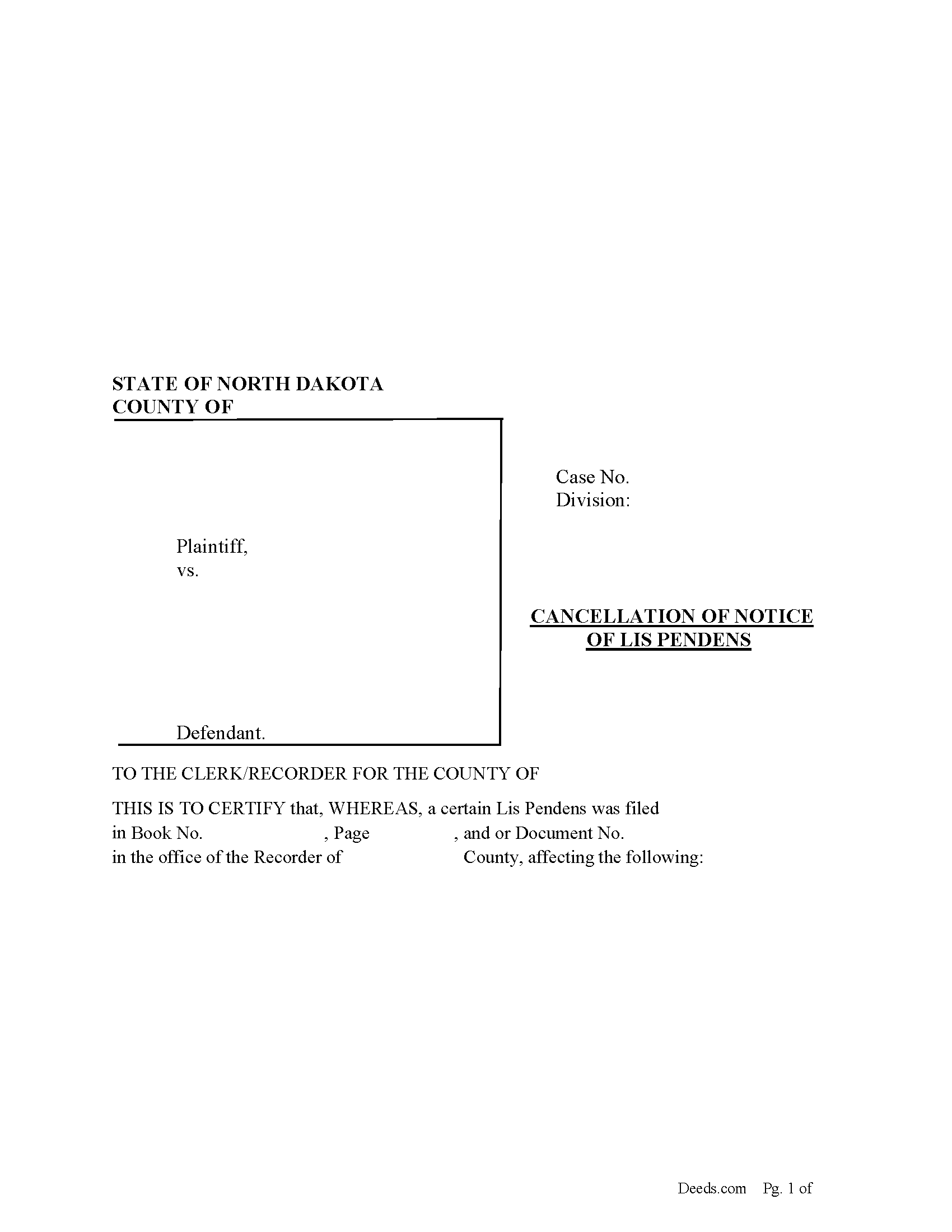
Use this form to cancel a previously recorded notice of lis pendens. This can be done by the court, the litigant (typically the plaintiff), or the representative (typically the attorney).
28-05-08. Cancellation of lis pendens.
The court in which the action was commenced, at any time, on application of any person aggrieved and on good cause shown and on such notice as directed or approved by the court, may order the notice authorized by section 28-05-07 to be canceled of record in whole or in part by the recorder of any county in whose office the same may have been filed for record, and such cancellation must be made by an endorsement to that effect on the margin of the record which shall refer to the order. Such cancellation, in like manner, may be made by the recorder upon a written request, directing such cancellation, signed by the party or the attorney of the party who caused such notice to be filed. Such notice is also canceled by the entry of a final judgment in the action if no appeal has been taken from such judgment within the time provided
(North Dakota Cancellation of Notice of LP Package includes form, guidelines, and completed example) For use in North Dakota on... More Information about the North Dakota Cancellation of Notice of Lis Pendens
Mortgage Security Agreement and Promissory Note
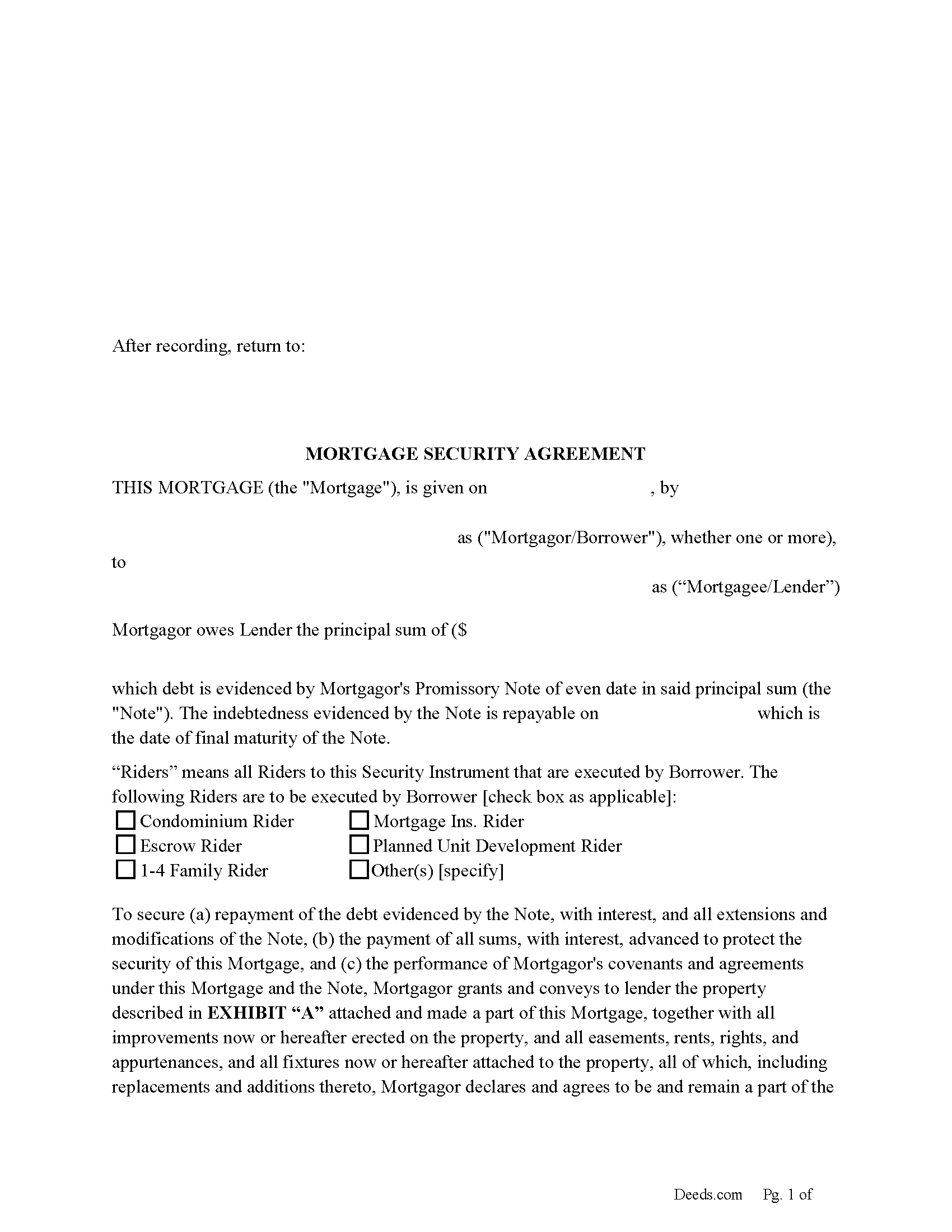
35-03-01.2. Nature, extent, and effect of lien - Security not to be impaired.
1. A mortgage is a lien upon everything that would pass by a grant of the property, and upon nothing more.
2. A mortgage is a lien upon the property mortgaged in the hands of everyone claiming under the mortgagor subsequently to its execution, except purchasers and encumbrancers in good faith without notice and for value.
3. Real property held adversely to the mortgagor may be mortgaged, and such a mortgage takes effect from the time at which the mortgagor or one claiming under the mortgagor obtains possession of the property and has precedence over every lien upon the mortgagor's interest in the property created subsequently to the recording of the mortgage.
4. Title acquired by the mortgagor subsequent to the execution of the mortgage inures to the mortgagee as security for the debt in like manner as if acquired before the execution.
5. In the absence of an express covenant, a mortgage does not bind the mortgagor personally to perform the act for the performance of which it is a security.
6. A mortgage does not entitle the mortgagee to the possession of the property, but after the exec... More Information about the North Dakota Mortgage Security Agreement and Promissory Note
Certificate of Discharge of a Mortgage
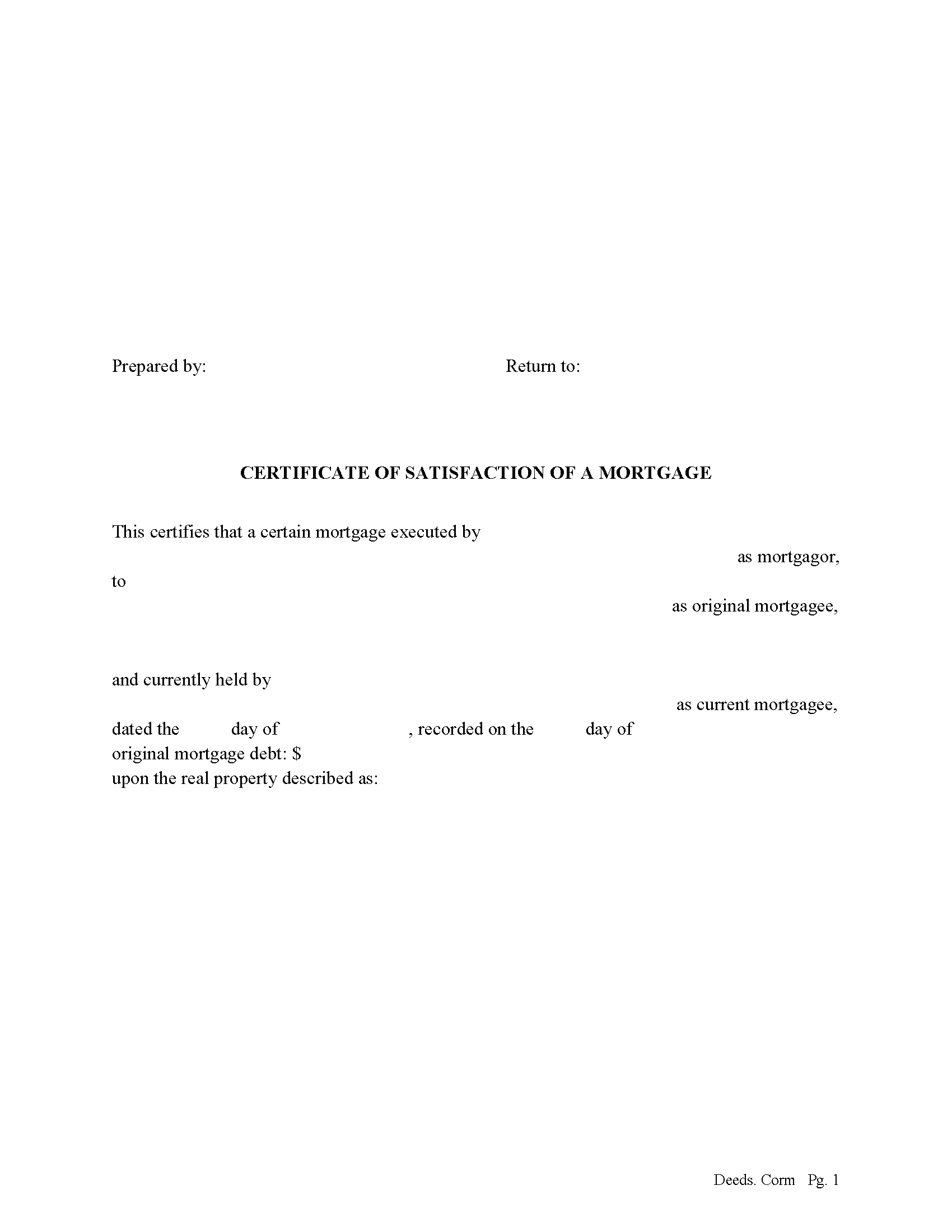
Use this form to discharge a previously recorded mortgage of record. (The certificate of discharge must contain a brief description of the mortgage and must state that the mortgage has been paid in full or otherwise satisfied and discharged and that the officer is authorized to discharge the mortgage of record.) (The mortgagee)/lender (shall present the certificate of discharge to the recorder for recording in the county in which the property is located within thirty days after the certificate of discharge is signed. The mortgagee may add the amount of the recording fee to the balance of the debt paid by the mortgagor.) This form can be (signed by the mortgagee, the mortgagee's executors, administrators, guardians, trustees, assigns, personal representatives, or special administrators appointed for that purpose, properly acknowledged or proved and certified as prescribed by chapter 47-19.) (35-03-16. Satisfaction of mortgage.)
(North Dakota Discharge of Mortgage Package includes form, guidelines, and completed example) For use in North Dakota only.
... More Information about the North Dakota Certificate of Discharge of a Mortgage
Assignment of Mortgage
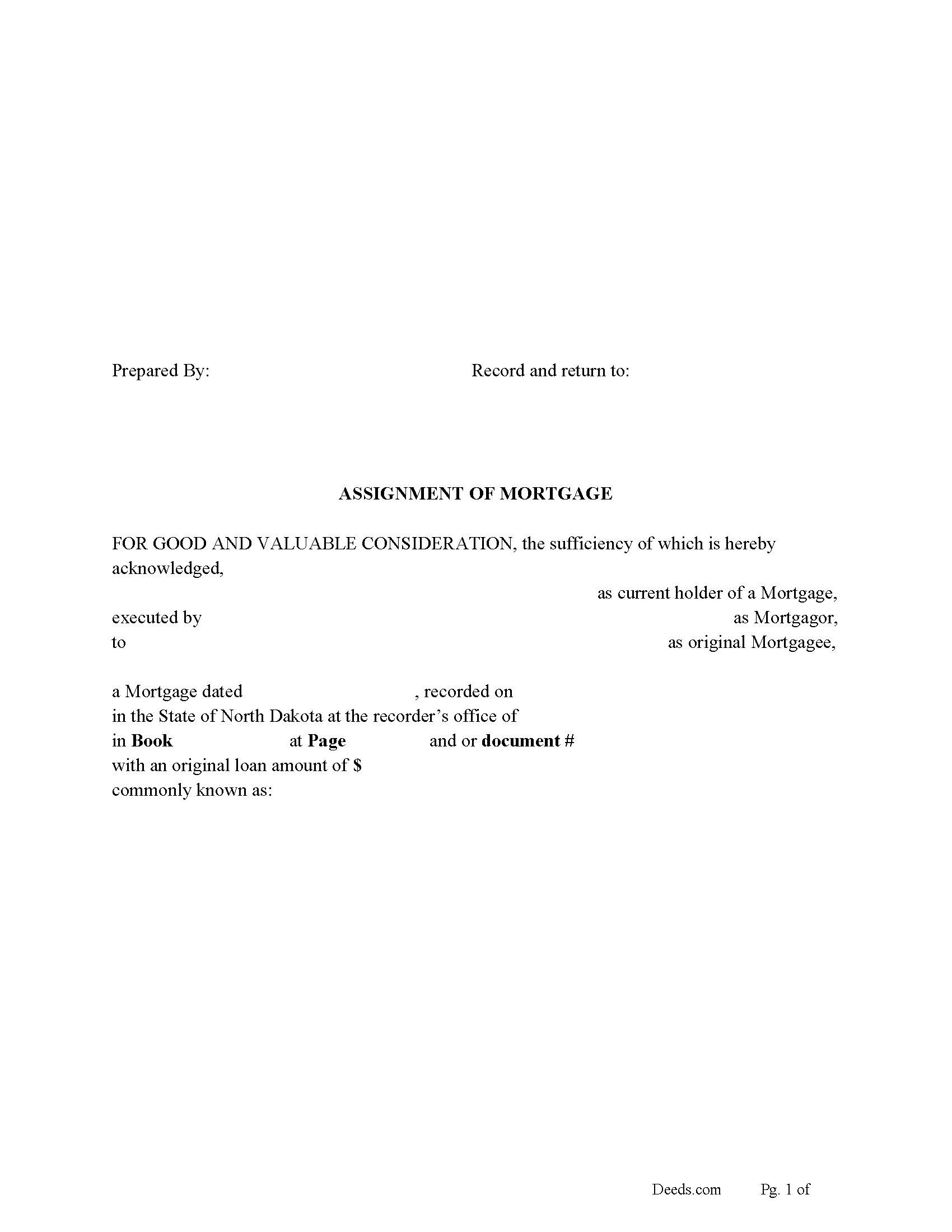
Use this form to assign a previously recorded mortgage to another party/assignee. (An assignment of a mortgage on real property which does not contain the post-office address of the assignee may not be received for record.) (35-03-04.)
35-03-05.1. Recording and filing assignment of mortgage - Notice to whom.
An assignment of a mortgage may be recorded or filed in the same manner as a mortgage, and the record thereof operates as notice to all persons subsequently deriving title to the mortgage from the assignor. When the mortgage is executed as security for money due or to become due on a promissory note, bond, or other instrument designated in the mortgage, the record of the assignment of the mortgage is not of itself notice to a mortgagor or a mortgagor's heirs or personal representatives so as to invalidate any payment made by them or either of them to the person holding such note, bond, or other instrument.
Current Borrowers must be notified of the assignment. Notification consists of contact information of the new creditor, recording dates, recording instrument numbers, changes in loan, etc. Included are "Notice of Assignment of Mortgage" forms.
The Truth and lending ... More Information about the North Dakota Assignment of Mortgage
Transfer of Death Deed
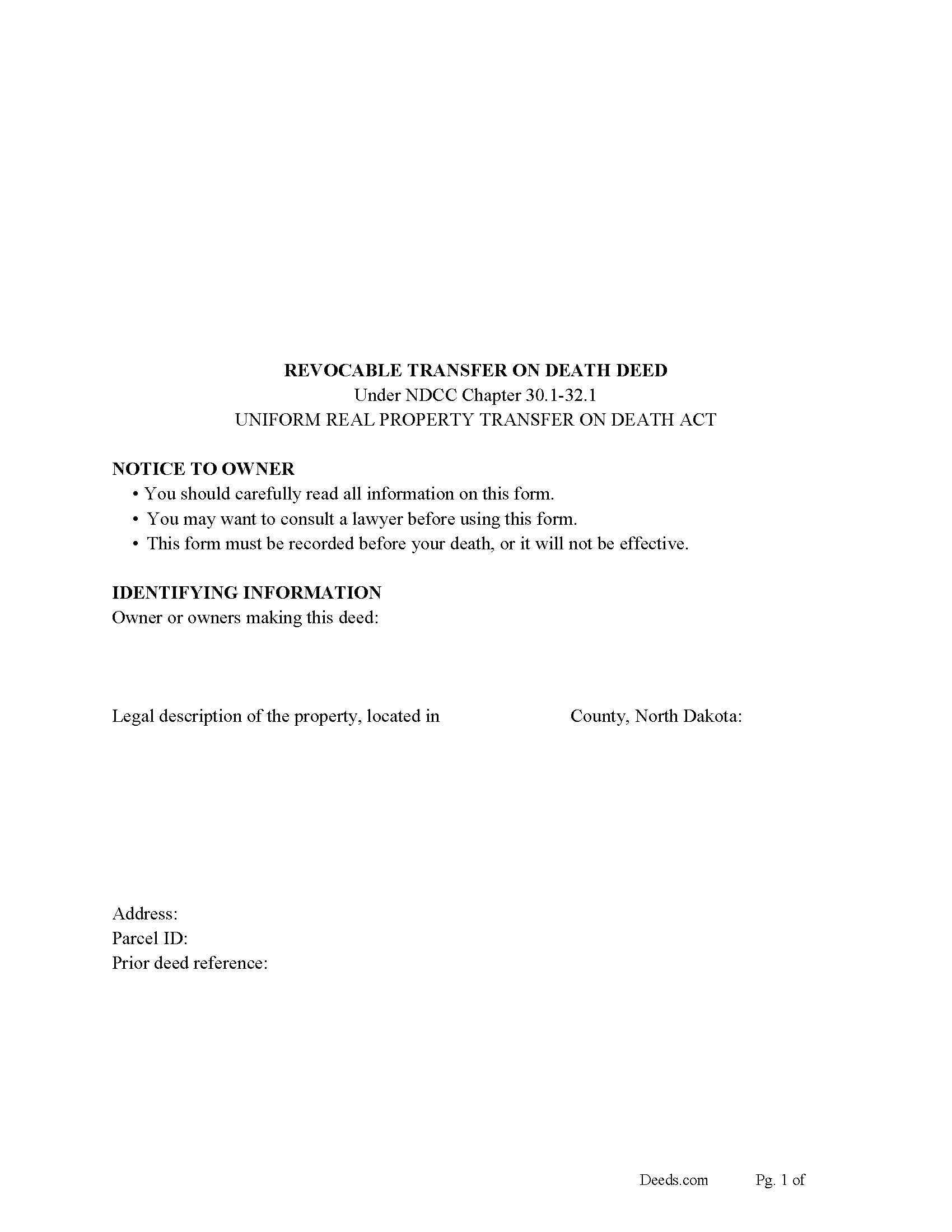
Note that transfer on death deeds must be recorded during the owner's life or they have no effect.
In 2011, North Dakota enacted the Uniform Real Property Transfer on Death Act, found in the North Dakota Century Code (NDCC) at Chapter 30.1-32.1.
According to this statute, owners of North Dakota real property may transfer property to one or more beneficiaries effective, at the transferor's death, by lawfully executing and recording a transfer on death deed in the county or counties where the property is located (NDCC 32.1-02). The instruments must contain all the information required for traditional deeds, as well as a statement that the transfer will occur at the owner's death (30.1-32.1-06).
This transfer is nontestamentary, meaning it is not included in the owner's will (30.1-32.1-04). As a result, it does not require probate distribution. Even so, best practices dictate that the will and any other transfers should not contain any conflicting instructions.
Deeds under this law allow the owners to retain absolute ownership of and control over the land until death, including the ability to cancel or change the beneficiary designation, and to sell the property outrigh... More Information about the North Dakota Transfer of Death Deed
Transfer on Death Deed Revocation
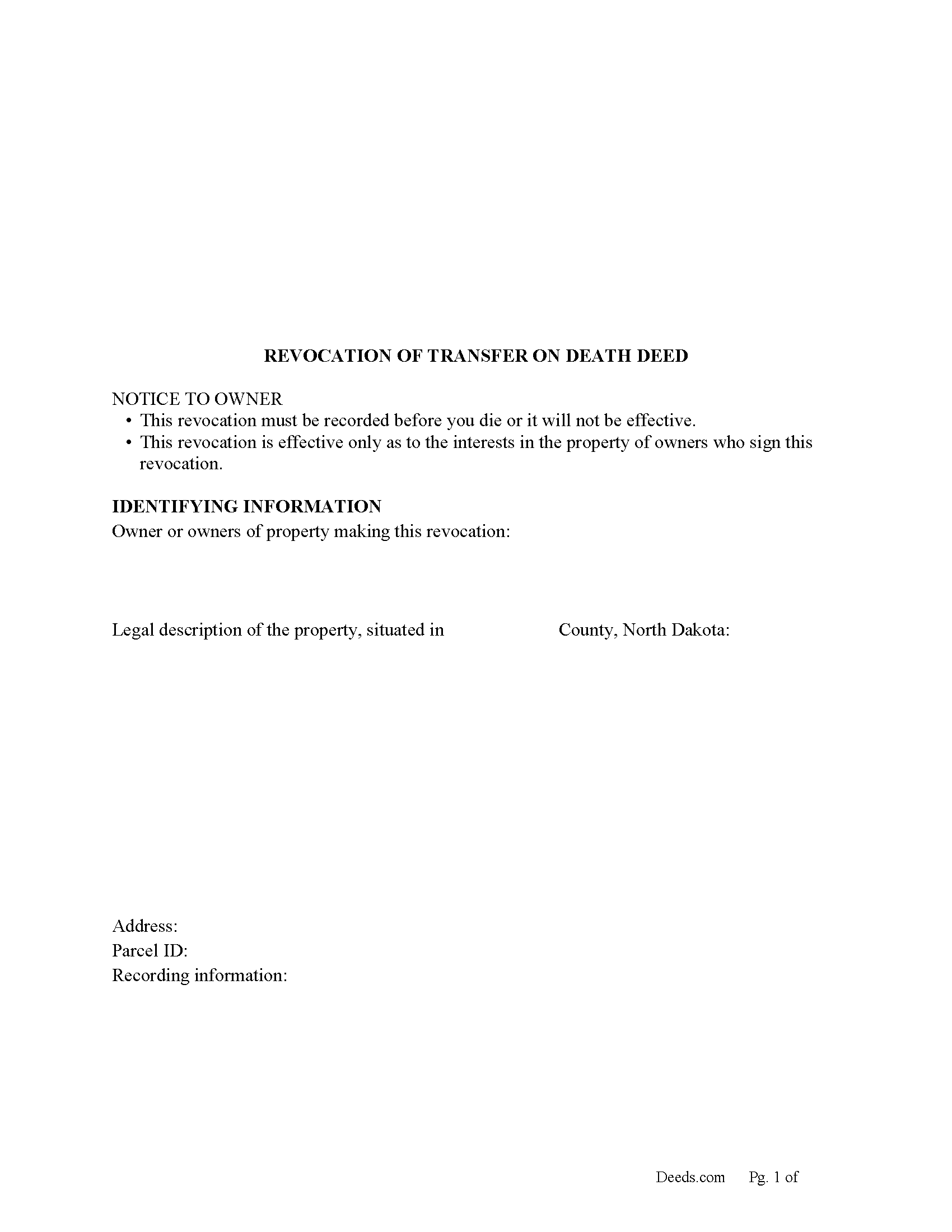
Revoking North Dakota's Transfer on Death Deeds
Note that revocations of transfer on death deeds must be recorded during the owner's life or they have no effect.
In 2011, North Dakota enacted the Uniform Real Property Transfer on Death Act, found in the North Dakota Century Code (NDCC) at Chapter 30.1-32.1.
According to this statute, owners of North Dakota real property may transfer property to one or more beneficiaries effective, at the transferor's death, by lawfully executing and recording a transfer on death deed (TODD) in the county or counties where the property is located (NDCC 32.1-02). The instruments must contain all the information required for traditional deeds, as well as a statement that the transfer will occur at the owner's death (30.1-32.1-06).
This transfer is nontestamentary, meaning it is not included in the owner's will (30.1-32.1-04). As a result, it does not require probate distribution. Even so, best practices dictate that the will and any other transfers should not contain any conflicting instructions.
Deeds under this law allow the owners to retain absolute ownership of and control over the land until death, including the ability to cance... More Information about the North Dakota Transfer on Death Deed Revocation
Transfer on Death Affidavit
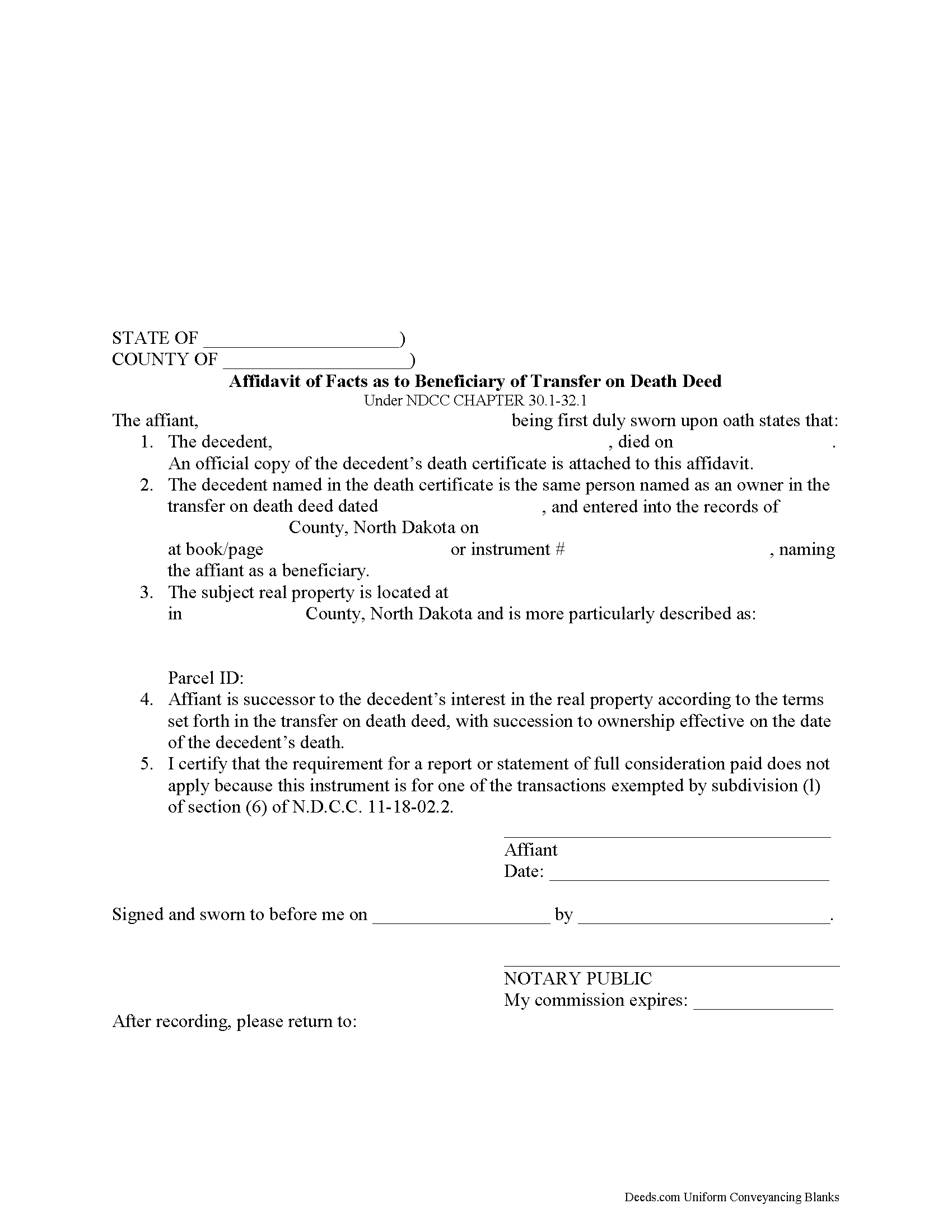
Taking Ownership of Property from a North Dakota Transfer on Death Deed
In 2011, North Dakota enacted the Uniform Real Property Transfer on Death Act, found in the North Dakota Century Code (NDCC) at Chapter 30.1-32.1.
Under this statute, owners of North Dakota real property may transfer title to one or more beneficiaries, effective at the transferor's death, by lawfully executing and recording a transfer on death deed in the county or counties where the property is located (NDCC 32.1-02).
This transfer is nontestamentary, meaning it is not included in the owner's will (30.1-32.1-04). As a result, it does not require probate distribution. Instead, the beneficiary gains ownership of the property when the transferor dies.
To formalize the change in ownership, beneficiaries complete and record an affidavit, confirming their acceptance of the transfer. Along with the affidavit, they must submit an official copy of the deceased owner's death certificate. This process enters the new information into public records and maintains a clear chain of title (ownership history).
Contact an attorney with specific questions or for complex situations.
(North Dakota TOD Affidavi... More Information about the North Dakota Transfer on Death Affidavit
Trustee Deed
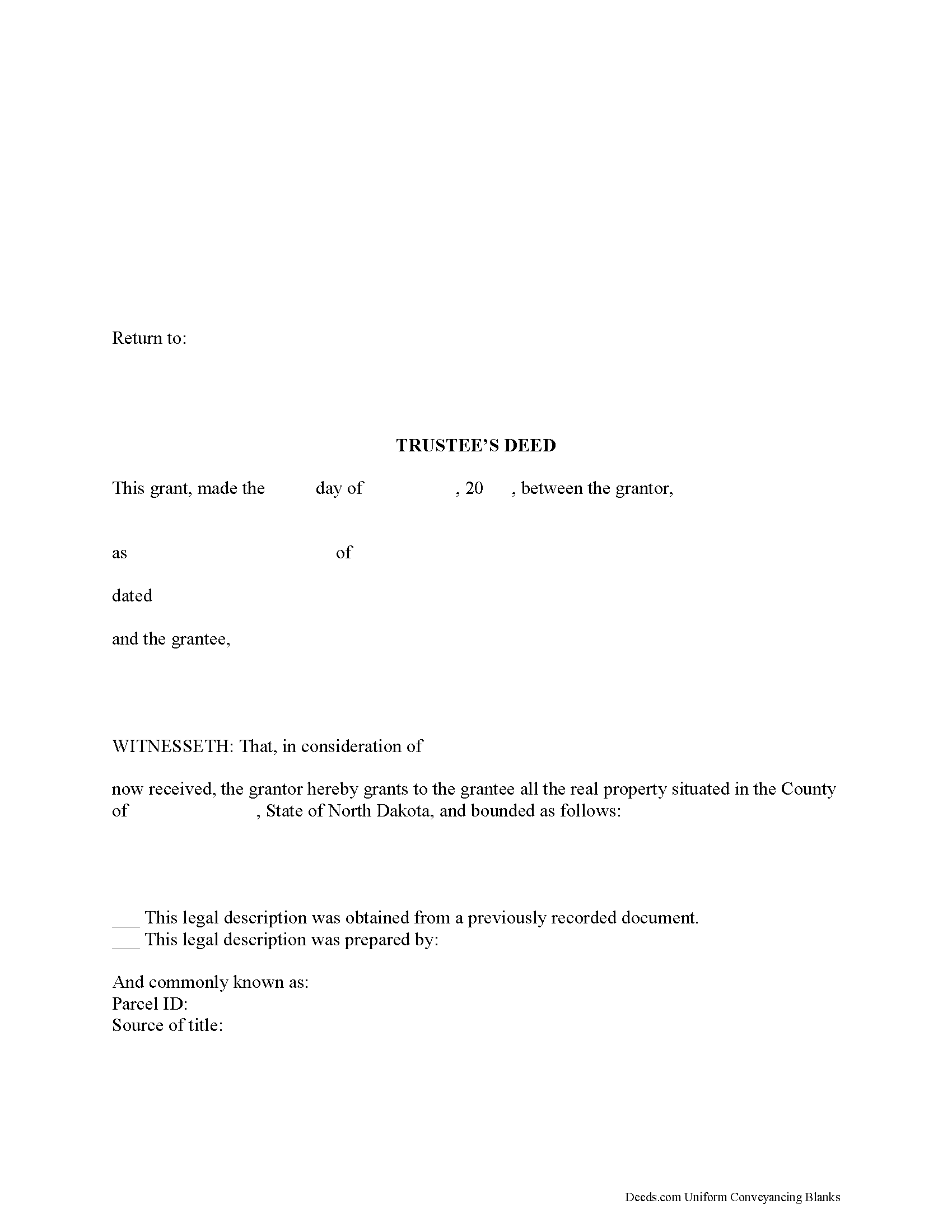
Transferring Real Property from a Trust in North Dakota
A trust is an arrangement whereby a person (the grantor or settlor) transfers property to another (the trustee) for the benefit of a third (the beneficiary). In general, trusts in North Dakota are governed by Chapters 59-09 through 59-19 of the North Dakota Century Code as the North Dakota Uniform Trust Code.
To create a trust, the settlor transfers property to a trustee either during his lifetime (an inter vivos trust) or by will upon his death (a testamentary trust) (N. D. Cent. Code 59-12-01). It must be created for lawful purposes and have a definite beneficiary, or a person with "a present or future beneficial interest in a trust, vested or contingent, including the owner of an interest by assignment or transfer" ( 59-09-05, 59-12-04; 59-09-03(3)(a)).
In North Dakota, trusts relating to real property are invalid without a written instrument signed by the trustee ( 59-12-18). The trust instrument is an unrecorded document executed by the settlor that "contains [the] terms of the trust, including any amendments to the record" ( 59-09-03(25)). In addition to designating the trustee (and successor, if the settlor ... More Information about the North Dakota Trustee Deed
Personal Representative Deed of Distribution
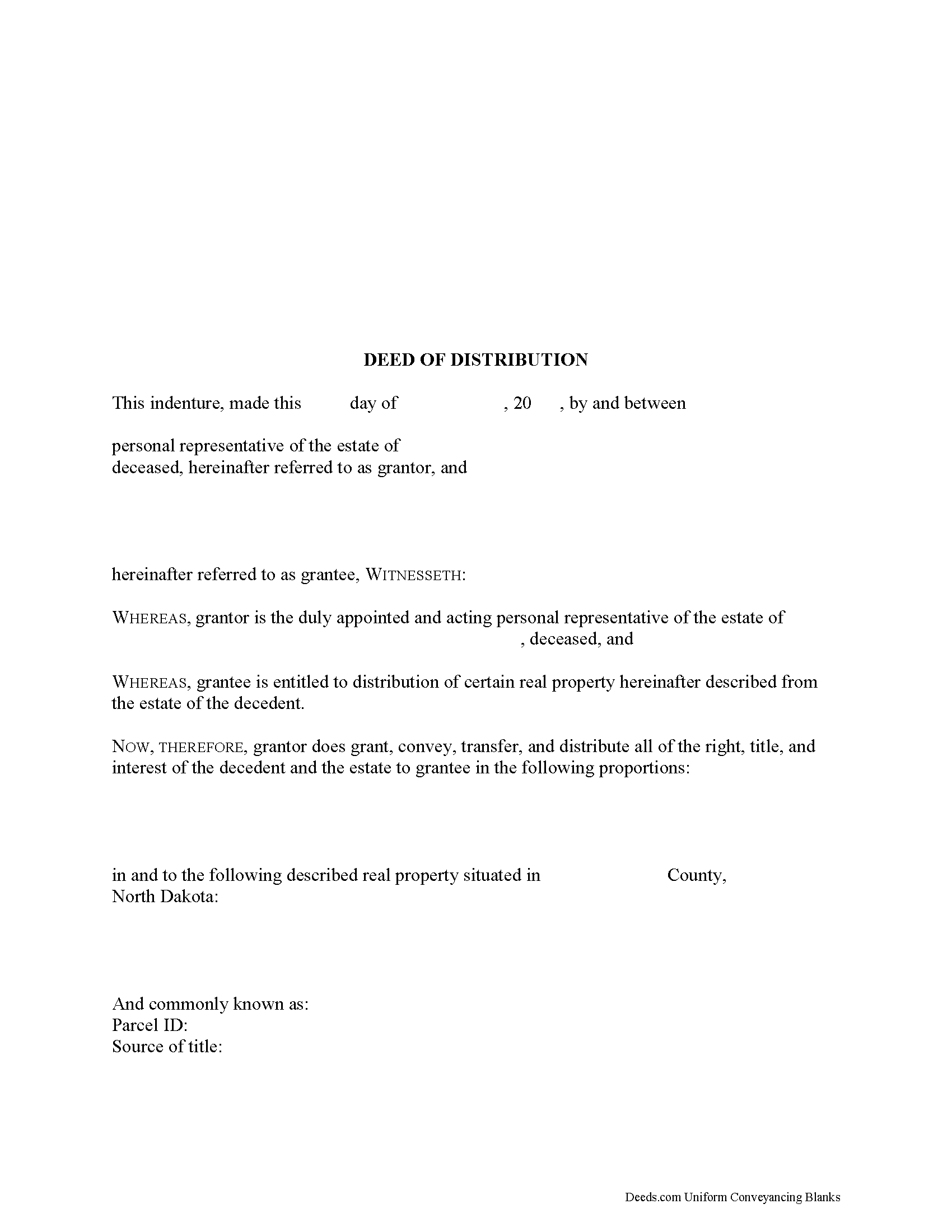
Probate is the legal process of settling and distributing a decedent's estate according to the provisions of a will or the relevant jurisdiction's laws of intestate succession. The personal representative (PR) is the fiduciary authorized by the district court to administer the estate.
A deed of distribution is a probate instrument executed by a PR to evidence the passing of title to realty from a decedent to his or her devisees or heirs.
In North Dakota, title passes to devisees or heirs upon death by process of law, subject to rights of creditors and administration (N.D.C.C. 30.1-12-01). The deed of distribution is recorded as evidence of title only, and states on the record that the property is not needed to pay claims on the estate, and the PR waives the statutory right to bring the property into the estate.
A deed of distribution includes statements that the grantor is the duly appointed and acting PR of the estate, and that the within named grantee is entitled to distribution of the property described within. In addition to naming each grantee, the deed states in what proportion each grantee succeeds to an interest in the property.
The PR must sign the deed in th... More Information about the North Dakota Personal Representative Deed of Distribution
Personal Representative Deed of Sale
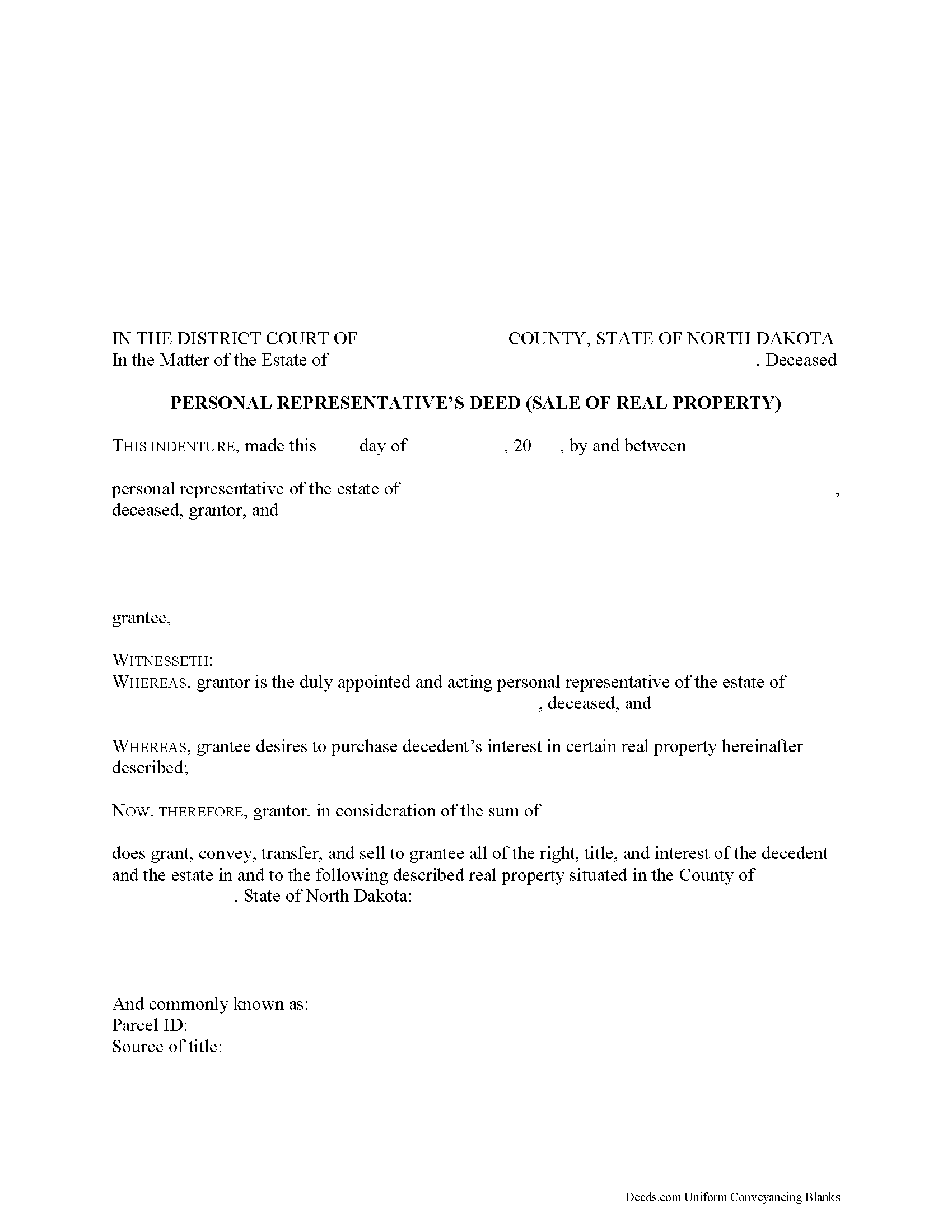
Probate is the legal process of settling and distributing a decedent's estate according to the provisions of a will or the relevant jurisdiction's laws of intestate succession. The personal representative (PR) is the fiduciary authorized by the district court to administer the estate.
In North Dakota, title passes to devisees or heirs upon death by process of law, subject to rights of creditors and administration (N.D.C.C. 30.1-12-01). In some cases, the PR may need to sell realty to pay claims on the estate using the proceeds from the sale. The Uniform Probate Code authorizes PRs to enter certain transactions, including the sale of real property of the estate (N.D.C.C. 30.1-18-15(23)). In other instances, a PR may need to petition the district court for partition of a parcel to facilitate distribution (30.1-20-11). If partition cannot be made, the court may order a sale of real property.
A personal representative's deed is a probate instrument executed by a PR to transfer title to realty from an estate to a purchaser after a sale.
The personal representative's deed for a sale of real property conveys the decedent's interest in the subject property to the within named gra... More Information about the North Dakota Personal Representative Deed of Sale
Certificate of Trust
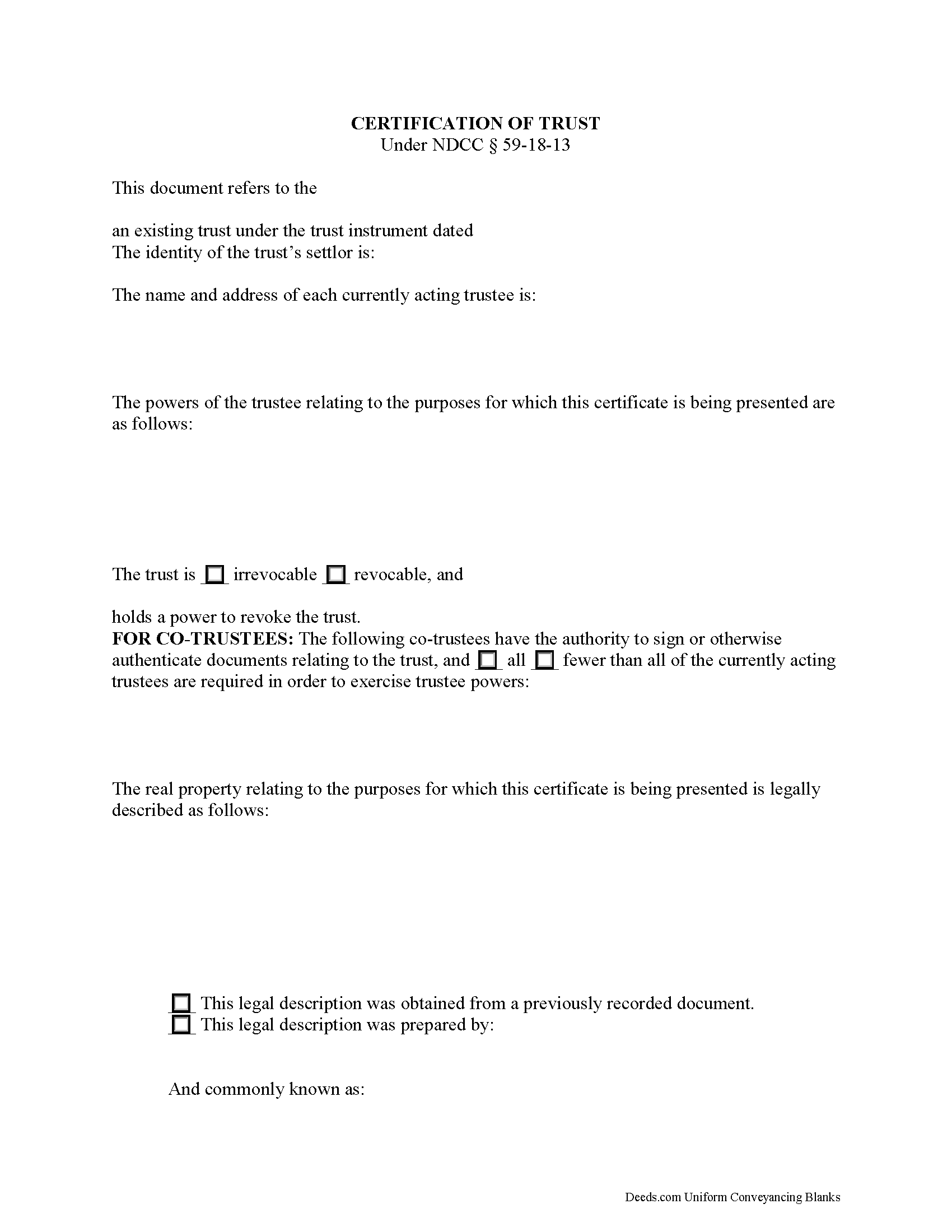
Codified at N. D. Cent. Code 59-18-13 as part of the North Dakota Uniform Trust Code, the certification of trust is a document containing essential information about a trust. A trustee can present a certificate when entering transactions on behalf of a trust. As the name suggests, the form certifies the trust's existence and the trustee's authority to conduct business in the trust's name, and its recipient may rely upon the facts contained within it without further inquiry ( 59-18-13(6)).
A trust is an arrangement whereby a settlor (or grantor) transfers property to another person (trustee) to be held for the benefit of third (beneficiary). The trust is governed by the terms expressed in the trust instrument, a (generally) unrecorded document that designates the trustee, contains the scope of the trust's assets, and identifies the trust's beneficiaries. Some types of trust take effect during the settlor's lifetime (inter vivos trust), and others take effect upon the death of the settlor (testator), as provided for by a will (testamentary trust).
In North Dakota, the certification states that the trust exists and provides the trust's name and effective date of the trust instr... More Information about the North Dakota Certificate of Trust
Disclaimer of Interest
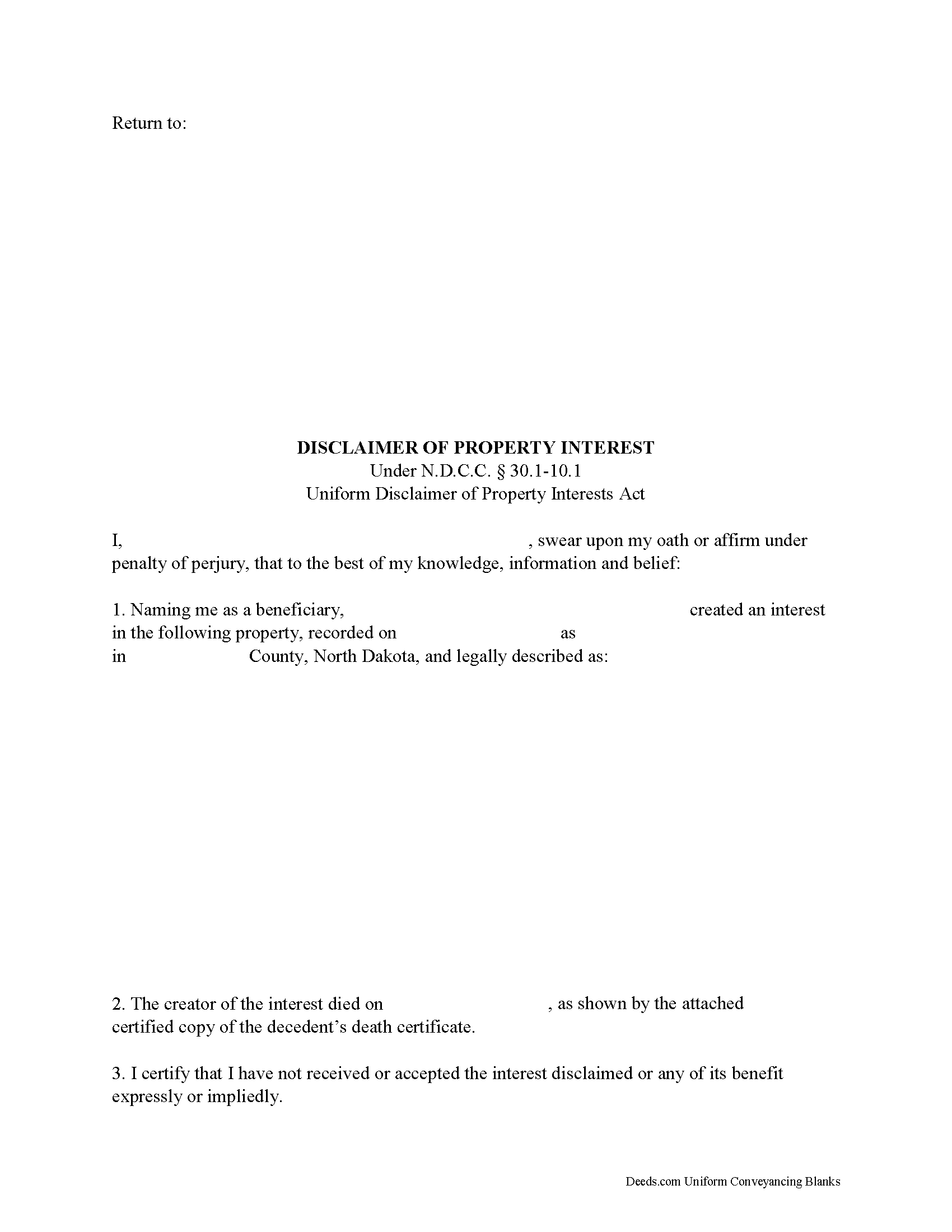
North Dakota Disclaimer of Property Interest
Under the North Dakota Century Code, the beneficiary of an interest in property may disclaim the gift, either in part or in full (N.D.C.C. 30.1-10.1 Uniform Disclaimer of Property Interests Act). Note that the option to disclaim is only available to beneficiaries who have not acted in any way to indicate acceptance or ownership of the interest ( 30.1-10.1-10).
The document must be in writing and include a description of the interest, a declaration of intent to disclaim all or a defined portion of the interest, and be signed by the disclaimant ( 30.1-10.1-02).
Deliver the disclaimer within nine months of the transfer (e.g., the death of the creator of the interest) to the personal representative of the decedent's estate or the trustee, or file it with the court having authority to appoint such a person ( 30.1-10.1-09). If real property is involved, avoid any ambiguity regarding the chain of title by recording a copy of the document with the recorder of the county in which the property is located ( 30.1-10.1-11).
A disclaimer is irrevocable and binding for the disclaiming party and his or her creditors ( 30.1-10.1-01), s... More Information about the North Dakota Disclaimer of Interest